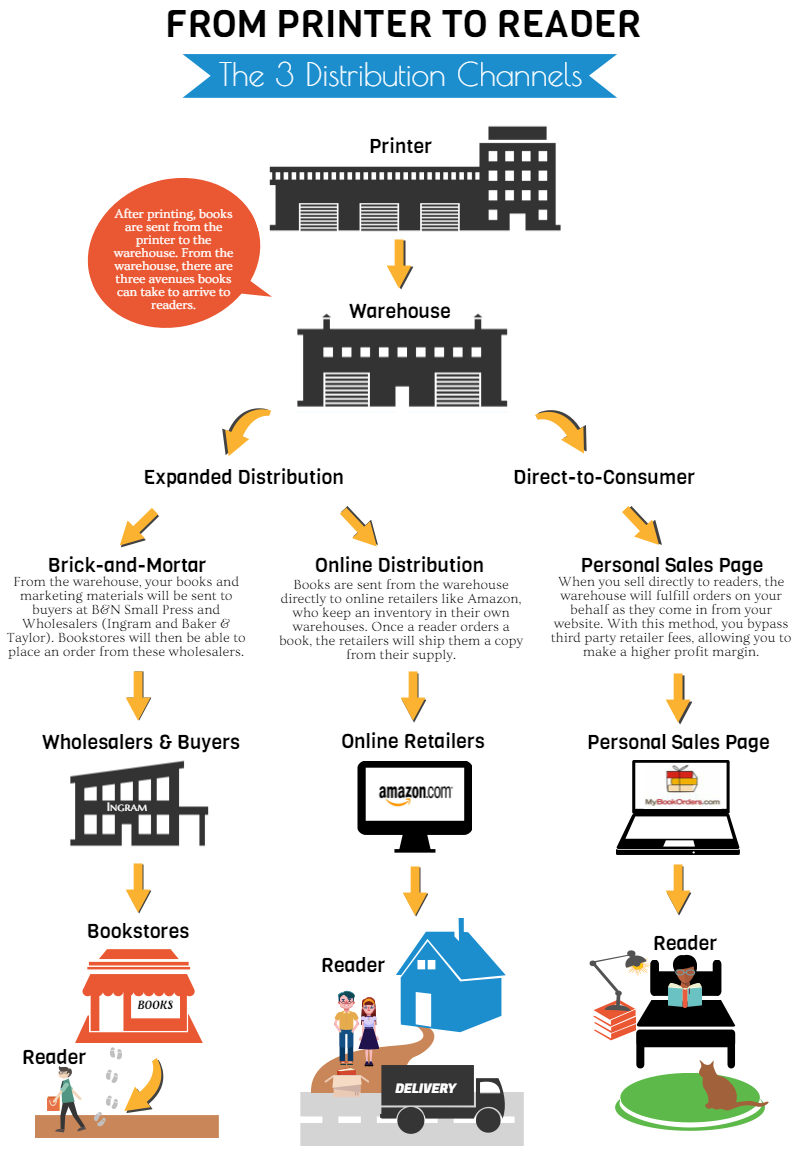Part
01
of one
Part
01
Physical Book/Print Distribution
Key Takeaways
- Wholesale distribution is one of the most common print or physical book distribution methods. This print distribution uses established book wholesalers, including Baker & Taylor and Ingram, to offer book orders fulfillment from libraries and bookstores.
- The direct-to-consumer fulfillment is a print/book distribution method allowing the book author to sell books directly to consumers. This is typically done through a personal sales page.
- Print-on-demand distribution is a relatively new method, but it is already widely used. This distribution method combines digital printing and digital/online distribution.
Introduction
This research presents insights into the conventional and unconventional ways of print/physical book distribution. Wholesale distribution and expanded distribution are some traditional ways of print distribution, while print-on-demand distribution and self-distribution are some unconventional ways. The details are outlined below.
I. Traditional Ways of Print/Physical Book Distribution
Traditional Book Distribution
- The traditional book distribution method is a kind of distribution where the book is printed in advance and then stored in a warehouse. A distributor afterward fulfills the book orders through printed inventory.
- This distribution method offers lower printing costs per book since the printing is done in bulk quantities.
- Traditional distribution is a suitable print distribution method for children's books.
Mill City Press's Traditional Distribution Service
- Mill City Press is one of the publishers utilizing the traditional distribution method. Mill City's traditional distribution service has a distributor handling all incoming orders for the book.
- In addition, Mill City's distributors also send book copies and marketing materials to Ingram, Barnes & Noble, Follett, and Baker & Taylor. Ingram is one of the major US book distributors.
Wholesale Distribution
- Wholesale distribution is one of the most common print or physical book distribution methods. This print distribution uses established book wholesalers, including Baker & Taylor and Ingram, to offer book orders fulfillment from libraries and bookstores.
- For wholesale distribution, there's usually a minimum number of book copies that would be printed.
- Wholesale distribution is a print distribution method that is dependent on authors and publishers to drive sales. Wholesalers are basically passively suppliers.
Trade Distribution
- Trade distribution is a print distribution method that uses the traditional distribution process but with an established distributor. Distributors sell to wholesalers, but wholesalers never sell to distributors.
- Distributors perform multiple functions in this method, such as order fulfillment, sales, and warehousing. Distributors sell new books to libraries and bookstores before the books are even published.
- Trade distribution is usually associated with higher costs. Thus, a minimum of 1,500 to 3,000 book copies are normally required for printing and distribution.
Expanded Distribution: Brick-and-Mortar
- The expanded distribution is similar to the traditional book distribution method since it also stores books in a warehouse before being shipped out. In this distribution method, books get shipped out only when a wholesaler orders copies.
- Wholesalers such as Baker & Taylor allows for distributing books in brick-and-mortar bookstores.
- BookPrinting.com is one of the book publishers utilizing this expanded distribution method. Wholesalers and online retailers display the book author's distribution listing, which BookPrinting.com releases once the inventory arrives at their warehouse.
- The distribution listing is where consumers search for and buy the book. The first part of the image below shows this kind of distribution method.
II. Unconventional Ways of Print/Physical Book Distribution
Direct-to-Consumer Fulfillment
- The direct-to-consumer fulfillment is a print/book distribution method allowing the book author to sell books directly to consumers. This is normally done through a personal sales page.
- BookPrinting.com utilizes this distribution method. This publishing house supplies the sales page that serves as an online bookstore. Authors can use the sales page to offer discounts or create promo codes.
Expanded Distribution: Online Distribution
- The expanded distribution through online retailers allows for displaying the book author's distribution listing by online retailers.
- BookPrinting is one of the publishers using this method. In this method, an online retailer such as Amazon would order a book from BookPrinting's warehouse, which will then be shipped to Amazon's warehouse. Amazon will then ship the printed book to the customer.
Consignment and Self-Distribution
- The consignment and self-distribution method is recommended for self-published authors. In this distribution method, self-published authors offer book copies to local bookstores on a consignment basis.
- The local bookstore will stock book copies for a specified period, and the author is paid once a book is sold, normally as a lump sum after the specified period.
- Unsold book copies are then returned to the author after the designated period.
- The process is renewed once the book is seen to be selling well.
Print-On-Demand (POD) Distribution
- Print-on-demand distribution is a relatively new method, but it is already widely used. This distribution method combines digital printing and digital/online distribution.
- Digital distribution means the book cover with the catalog copy is posted on sites such as Amazon and Barnes & Noble, where the book is being sold. When a customer buys from the site, the book is then printed and delivered to the customer.
Book Baby's POD Distribution
- Book Baby is one of the publishers utilizing print-on-demand distribution. Book Baby starts printing book copies only when a wholesaler or retailer places an order.
- This allows book authors to sell books in stores with no warehousing and minimum upfront costs.
Research Strategy
For this research on physical book/print distribution, we leveraged the most reputable sources of information in the public domain, including Mill City Press, Book Printing, Epigraphs, Ingram Spark, and Book Baby.
